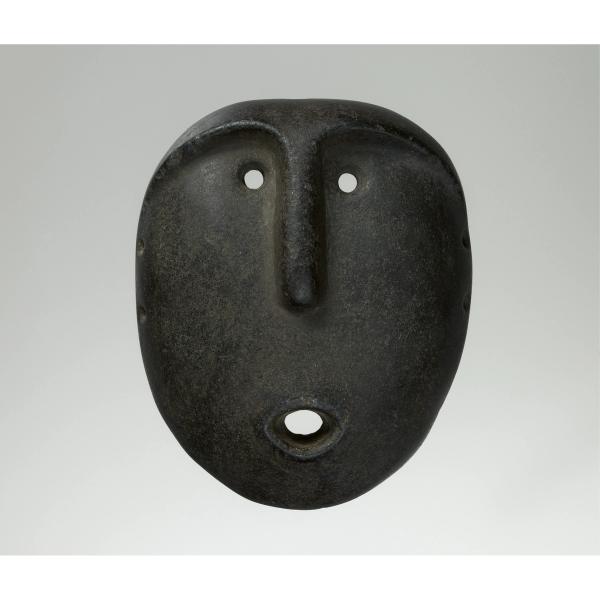Mask
The Condorhuasi-Alamito peoples were llama pastoralists in the area that is now the Catamarca province of Argentina. They were skilled artisans in a variety of media, including ceramic, metal, and stone. Archaeological evidence suggests that the Condorhuasi-Alamito peoples maintained extensive long-distance contacts with other regions, including the important site of Tiwanaku, near Lake Titicaca in what is now Bolivia.
Artwork Details
- Title:Mask
- Artist:Condorhuasi-Alamito artist(s)
- Date:400 BCE–500 CE
- Geography:Argentina, Northwest Argentina
- Culture:Condorhuasi-Alamito
- Medium:Stone
- Dimensions:H. 6 3/4 × W. 5 1/2 × D. 2 in. (17.1 × 14 × 5.1 cm)
- Classification:Stone Sculpture
- Credit Line:Gift of Claudia Quentin, 2016
- Object Number:2016.734.4
- Curatorial Department: The Michael C. Rockefeller Wing
Audio

1645. Masks, Condorhuasi-Alamito artists
Benjamin Alberti
BENJAMIN ALBERTI: To us, masking is very much a theatrical performance, it’s about being somebody else, or pretending to be something else. I’ve held one up and you can’t see out of it because the eye holes don’t match up with your eye holes. So, they clearly weren’t being used to wear.
JOSÉ MARÍA YAZPIK (NARRATOR): These striking, expressive stone masks were created by people who lived in what is now northwest Argentina. Masks of this kind have been discovered in burial contexts. You can see holes on the outer edges of the masks, which might have been used to tie them onto funerary bundles.
Benjamin Alberti, Professor of Anthropology at Framingham State University.
BENJAMIN ALBERTI: This was a mask that transformed the person into one of the ancestral dead. Another way to look at it, maybe it is about revealing something that is there rather than masking something. So maybe the masks worked to bring out the ancestral qualities in that dead person as they continue their journey in the afterlife.
JOSÉ MARÍA YAZPIK: Notice that the eyes of the masks are left open, empty.
BENJAMIN ALBERTI: In Amazonian thought, staring, wide eyes are a sign that you cannot see… they’re a sign that you cannot see the invisible, which would be the spirits, other beings within the world. So, to present your mask with wide eyes that are hollow could be playing on this idea that the dead cannot see or the dead should not see. Perhaps is not able to see the living who remain, and so is not able to get involved, not able to cause problems for the living. So, it could be a form of limiting the capacities of that person, once they are dead.
So this really calls attention to the fact that these were objects that were designed to do things.
More Artwork
Research Resources
The Met provides unparalleled resources for research and welcomes an international community of students and scholars. The Met's Open Access API is where creators and researchers can connect to the The Met collection. Open Access data and public domain images are available for unrestricted commercial and noncommercial use without permission or fee.
To request images under copyright and other restrictions, please use this Image Request form.
Feedback
We continue to research and examine historical and cultural context for objects in The Met collection. If you have comments or questions about this object record, please contact us using the form below. The Museum looks forward to receiving your comments.